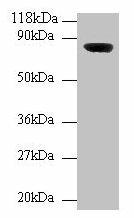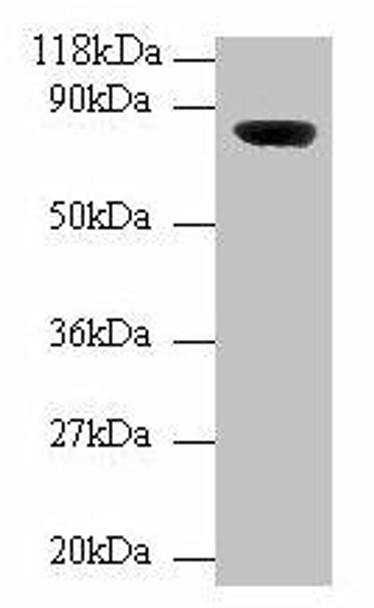Description
| Antibody Name: | Wdpcp Antibody (PACO37586) |
| Antibody SKU: | PACO37586 |
| Size: | 50ug |
| Host Species: | Rabbit |
| Tested Applications: | ELISA, WB |
| Recommended Dilutions: | ELISA:1:2000-1:10000, WB:1:1000-1:5000 |
| Species Reactivity: | Mouse |
| Immunogen: | Recombinant Mouse WD repeat-containing and planar cell polarity effector protein fritz homolog protein (1-722AA) |
| Form: | Liquid |
| Storage Buffer: | Preservative: 0.03% Proclin 300 Constituents: 50% Glycerol, 0.01M PBS, PH 7.4 |
| Purification Method: | >95%, Protein G purified |
| Clonality: | Polyclonal |
| Isotype: | IgG |
| Conjugate: | Non-conjugated |
 | Western blot. All lanes: Wdpcp antibody at 2µg/ml + Mouse brain tissue. Secondary. Goat polyclonal to rabbit IgG at 1/10000 dilution. Predicted band size: 82, 73 kDa. Observed band size: 82 kDa. |
| Background: | Probable effector of the planar cell polarity signaling pathway which regulates the septin cytoskeleton in both ciliogenesis and collective cell movements By similarity. |
| Synonyms: | WD repeat-containing and planar cell polarity effector protein fritz homolog (mFrtz) (Homolog-13) (WD repeat-containing and planar cell polarity effector protein), Wdpcp |
| UniProt Protein Function: | LOC51057: Probable effector of the planar cell polarity signaling pathway which regulates the septin cytoskeleton in both ciliogenesis and collective cell movements. Defects in WDPCP are the cause of Bardet-Biedl syndrome type 15 (BBS15). Bardet-Biedl syndrome (BBS) is a genetically heterogeneous, autosomal recessive disorder characterized by usually severe pigmentary retinopathy, early onset obesity, polydactyly, hypogenitalism, renal malformation and mental retardation. Secondary features include diabetes mellitus, hypertension and congenital heart disease. Bardet-Biedl syndrome inheritance is autosomal recessive, but three mutated alleles (two at one locus, and a third at a second locus) may be required for clinical manifestation of some forms of the disease. Mutations in WDPCP may act as modifiers of the phenotypic expression of Bardet-Biedl syndrome and Meckel syndrome by interacting in trans with primary BBS and MKS loci. Belongs to the WD repeat fritz family. 3 isoforms of the human protein are produced by alternative splicing.Cellular Component: cell projection; cilium; cytoplasm; cytoskeleton; membrane; plasma membraneMolecular Function: protein bindingBiological Process: auditory receptor cell morphogenesis; camera-type eye development; cell projection organization and biogenesis; cilium biogenesis; embryonic digit morphogenesis; embryonic organ development; establishment of protein localization; kidney development; nervous system development; palate development; regulation of focal adhesion formation; smoothened signaling pathway |
| UniProt Protein Details: | |
| NCBI Summary: | |
| UniProt Code: | Q8C456 |
| NCBI GenInfo Identifier: | 31981772 |
| NCBI Gene ID: | 216560 |
| NCBI Accession: | NP_663400.2 |
| UniProt Secondary Accession: | Q8C456,Q8BRR5, Q91ZJ2 |
| UniProt Related Accession: | Q8C456 |
| Molecular Weight: | 72,326 Da |
| NCBI Full Name: | WD repeat-containing and planar cell polarity effector protein fritz homolog |
| NCBI Synonym Full Names: | WD repeat containing planar cell polarity effector |
| NCBI Official Symbol: | Wdpcp |
| NCBI Official Synonym Symbols: | AV249152 |
| NCBI Protein Information: | WD repeat-containing and planar cell polarity effector protein fritz homolog |
| UniProt Protein Name: | WD repeat-containing and planar cell polarity effector protein fritz homolog |
| UniProt Synonym Protein Names: | Homolog-13; WD repeat-containing and planar cell polarity effector protein |
| Protein Family: | WD repeat-containing and planar cell polarity effector protein |
| UniProt Gene Name: | Wdpcp |
| UniProt Entry Name: | FRITZ_MOUSE |






